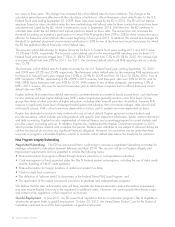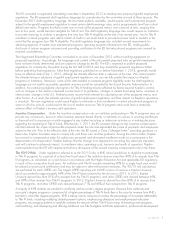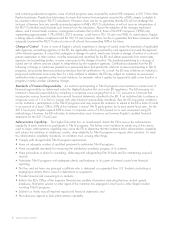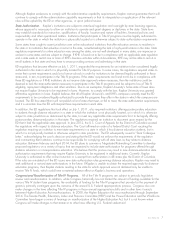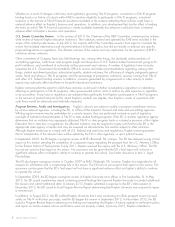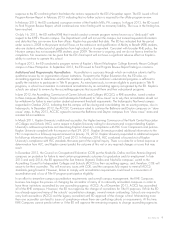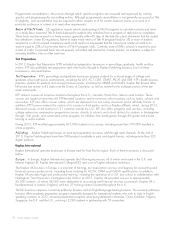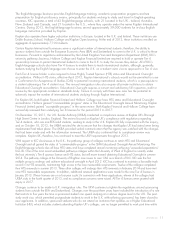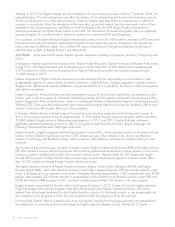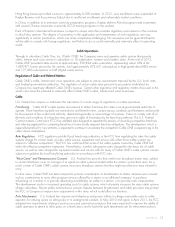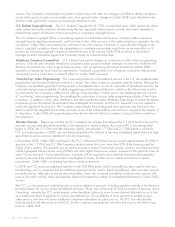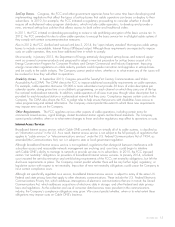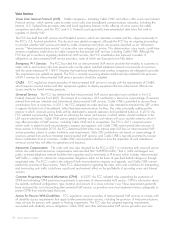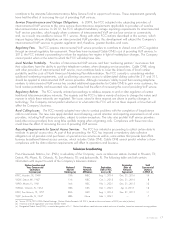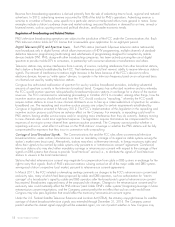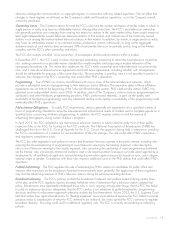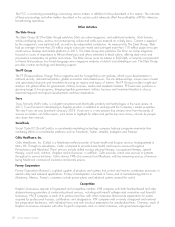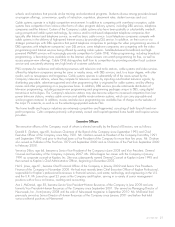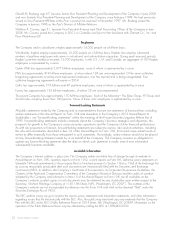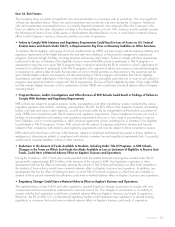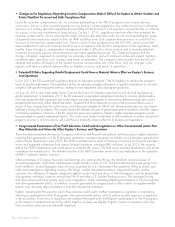Washington Post 2013 Annual Report Download - page 32
Download and view the complete annual report
Please find page 32 of the 2013 Washington Post annual report below. You can navigate through the pages in the report by either clicking on the pages listed below, or by using the keyword search tool below to find specific information within the annual report.services. The Company cannot predict the extent to which these and other rule changes will affect its ability over time to
secure timely access to poles at reasonable rates. As a general matter, changes to Cable ONE’s pole attachment rate
structure could significantly increase its annual pole attachment costs.
U.S. Federal Copyright Issues. The U.S. Federal Copyright Act of 1976, as amended, gives cable systems the ability,
under certain terms and conditions and assuming that any applicable retransmission consents have been obtained, to
retransmit the signals of television stations pursuant to a compulsory copyright license.
The U.S. Federal Copyright Office is considering requests for clarification and revisions of certain cable compulsory
copyright license reporting requirements, and from time to time, other revisions to the cable compulsory copyright rules are
considered. Cable ONE cannot predict the outcome of any such inquiries. However, it is possible that changes in the
rules or copyright compulsory license fee computations or compliance procedures could have an adverse effect on its
business by increasing copyright compulsory license fee costs or by causing Cable ONE to reduce or discontinue
carriage of certain broadcast signals that it currently carries on a discretionary basis.
Telephone Company Competition. U.S. Federal law permits telephone companies to offer video programming
services. Over the past decade, telephone companies have pursued multiple strategies to enter the market for the
delivery of multichannel video programming services, such as partnering with direct broadcast satellite (DBS)
operators or obtaining local franchise agreements. Increased competition from telephone companies that provide
competing services could have a material effect on Cable ONE’s business.
“Over-the-Top” Video Programming. The continued proliferation of broadband services in the U.S. has enabled cable
programmers and broadcast television stations to “stream” their video content to consumers over the Internet. Although the
Company has benefited generally from the growth in broadband due to its role as a provider of broadband services, the
continued and growing availability of cable programming and broadcast television content on the Internet may result in
less demand for the Company’s cable service offering. Some providers of cable service are marketing their own version
of “over-the-top” video programming, thus enabling their subscribers to access cable programming outside of their home
or business. In addition, online video distributors and other over-the-top video distributors have begun to stream broadcast
programming over the Internet. Broadcasters have challenged this practice, and the U.S. Supreme Court has agreed to
review the legality of this practice. The Company cannot predict how widespread these practices may become or the
extent to which the integrated functionality and ease of use of the cable platform will continue to appeal to the majority of
its subscribers. Cable ONE will be purchasing set-top devices that will allow its customers to access Internet content on
their televisions.
Wireless Services. Beginning in 2004, the FCC adopted rule changes that allowed the 2.5 GHz band to be used for
nonvideo services and permitted transmitters to be deployed in cellular patterns. As a result of FCC rule changes that
began in 2004, the 2.5 GHz and other frequency bands, including the 1.7 GHz and 2.1 GHz bands in which the
FCC auctioned spectrum in 2006, are now being adopted for the delivery of two-way broadband digital data and high-
speed Internet access services capable of covering large areas.
In December 2006, Cable ONE purchased in the FCC’s Advanced Wireless Service auction approximately 20 MHz of
spectrum in the 1.7 GHz and 2.1 GHz frequency bands in areas that cover more than 85% of the homes passed by
Cable ONE’s systems. This spectrum can be used to provide a variety of advanced wireless services, including fixed and
mobile high-speed Internet access using WiMAX and other digital transmission systems. Licenses for this spectrum have an
initial 15-year term and 10-year renewal terms. Licensees will be required to show that they have provided substantial
service by the end of the initial license term to be eligible to renew, but there are no interim construction or service
requirements. Cable ONE is evaluating how best to utilize its spectrum.
In 2008, the FCC auctioned additional spectrum in the 700 MHz band, which historically has been used for television
broadcasting, and it is expected that this additional spectrum will be used to deliver broadband, video and other services
to mobile devices. Although it is not yet clear what effect, if any, the increased availability of mobile video services will
have on the cable industry, these developments likely will increase the number of competitive alternatives to Cable ONE’s
services.
The FCC is in the process of establishing rules to auction additional spectrum, including spectrum currently in the television
broadcast band, for use by wireless broadband providers. These rules will provide for both the auction of spectrum and a
“repacking,” whereby the FCC would require certain broadcast stations to move to new channel allotments so as to free
up a nationwide block of spectrum for wireless broadband use. The availability of more spectrum to enable wireless
video services over time will create additional competitive alternatives to cable services. The FCC has indicated the
incentive auction will take place in mid-2015, but the Company cannot predict when this will occur or the effect it may
have on Cable ONE.
14 GRAHAM HOLDINGS COMPANY


